-
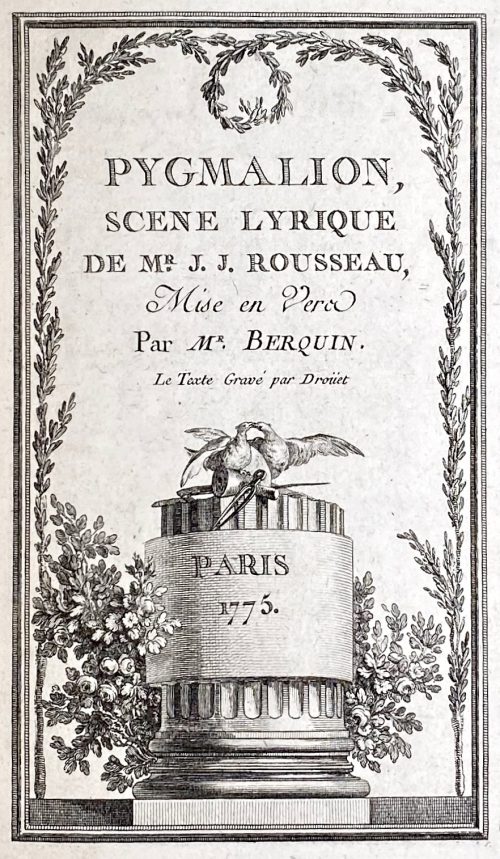 One volume, 22.8 x 15.5 cm, bound in full mottled calf, gilt floral frames to covers, raised bands and gilt fleurons to spine, printed on laid paper. Regarding Pygmalion, scène lyrique see: Wekipedia. Collation: Free endpaper and two blank flyleaves, [2] engraved title, [2] préface, 1-18 (Pygmalion), [2] f.t.p., [1] 2-8 (Idylle), two blank flyleaves and free endpaper; 20 leaves total, adorned with 7 headpieces and 1 tailpiece engraved by Nicolas de Launay, Nicolas Ponce and Charles Etienne Gaucher after Jean Michel Moreau the Younger and Clément Pierre Marillier; text engraved by Droüet. Title-page: PYGMALION, | SCENE LYRIQUE | DE MR. J. J. ROUSSEAU, | Mise en Vers | par MR. Berquin. | Le Text Gravé par Droüet | PARIS | 1775. || (on a column under two kissing doves and sculptor’s tools). Faux t.p.: IDYLLE | Par MR. Berquin. | — | Eructavit cor meum verbum bonum ; | dico ego opera mea regi. | Psalm. 44. | — || (in rules). Catalogue raisonné: Cohen-DeRicci 141 ; Lewine 55. Ref.: MFA (Boston); MET (NY); Yale University Library. Contributors: Artists: Jean-Michel Moreau le Jeune (French, 1741–1814) Clément Pierre Marillier (French, 1740–1808) Engravers: Nicolas Delaunay (French, 1739–1792) Charles-Étienne Gaucher (French, 1741–1804) Nicholas Ponce (French, 1746–1831) Droüet (French, 18th century) Authors: Arnaud Berquin (French, 1747–1791) Jean-Jacques Rousseau (French, 1712–1778)
One volume, 22.8 x 15.5 cm, bound in full mottled calf, gilt floral frames to covers, raised bands and gilt fleurons to spine, printed on laid paper. Regarding Pygmalion, scène lyrique see: Wekipedia. Collation: Free endpaper and two blank flyleaves, [2] engraved title, [2] préface, 1-18 (Pygmalion), [2] f.t.p., [1] 2-8 (Idylle), two blank flyleaves and free endpaper; 20 leaves total, adorned with 7 headpieces and 1 tailpiece engraved by Nicolas de Launay, Nicolas Ponce and Charles Etienne Gaucher after Jean Michel Moreau the Younger and Clément Pierre Marillier; text engraved by Droüet. Title-page: PYGMALION, | SCENE LYRIQUE | DE MR. J. J. ROUSSEAU, | Mise en Vers | par MR. Berquin. | Le Text Gravé par Droüet | PARIS | 1775. || (on a column under two kissing doves and sculptor’s tools). Faux t.p.: IDYLLE | Par MR. Berquin. | — | Eructavit cor meum verbum bonum ; | dico ego opera mea regi. | Psalm. 44. | — || (in rules). Catalogue raisonné: Cohen-DeRicci 141 ; Lewine 55. Ref.: MFA (Boston); MET (NY); Yale University Library. Contributors: Artists: Jean-Michel Moreau le Jeune (French, 1741–1814) Clément Pierre Marillier (French, 1740–1808) Engravers: Nicolas Delaunay (French, 1739–1792) Charles-Étienne Gaucher (French, 1741–1804) Nicholas Ponce (French, 1746–1831) Droüet (French, 18th century) Authors: Arnaud Berquin (French, 1747–1791) Jean-Jacques Rousseau (French, 1712–1778) -
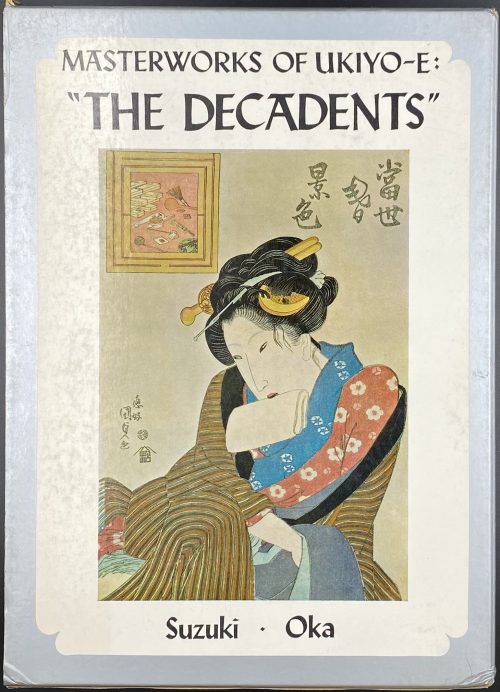 Description: Hardcover 26.5 x 19 cm, grey cloth, red lettering in kanji over black stripe to front, lettering to spine, tan endpapers, pictorial slipcase 27 x 19.5 cm; pp.: [1-6] 7-95 [96], pasted frontispiece and 79 colour illustrations with captions, within a collation. Series Masterworks of ukiyo-e, №8. ISBN: 9780870110986; 0870110985. Ref.: Worldcat Title-page (in frame): MASTERWORKS OF UKIYO-E | "THE DECADENTS” | by Jūzō Suzuki and Isaburō Oka | translation by John Bester | {publisher’s device} | KODANSHA INTERNATIONAL LTD. | Tokyo, Japan & Palo-Alto, Calif., U.S.A. || (Vertical text in kanji to the right, between rules). Artists: Utagawa Kunisada (Japanese [歌川 国貞], 1786 – 1865); Utagawa Kuniyoshi (Japanese [歌川 国芳], 1798 – 1861); Keisai Eisen [Japanese [渓斎 英泉], 1790 – 1848). Contributors: Jūzō Suzuki [鈴木重三] (Japanese, 1919 – 2010) – author. Isaburō Oka [岡畏三郎] (Japanese, 1914 –2010) – author. John Bester (British, 1927 – 2010) – translator Kunisada's fan print in this collection (exactly the same copy) [SVJP-0380.2022]:
Description: Hardcover 26.5 x 19 cm, grey cloth, red lettering in kanji over black stripe to front, lettering to spine, tan endpapers, pictorial slipcase 27 x 19.5 cm; pp.: [1-6] 7-95 [96], pasted frontispiece and 79 colour illustrations with captions, within a collation. Series Masterworks of ukiyo-e, №8. ISBN: 9780870110986; 0870110985. Ref.: Worldcat Title-page (in frame): MASTERWORKS OF UKIYO-E | "THE DECADENTS” | by Jūzō Suzuki and Isaburō Oka | translation by John Bester | {publisher’s device} | KODANSHA INTERNATIONAL LTD. | Tokyo, Japan & Palo-Alto, Calif., U.S.A. || (Vertical text in kanji to the right, between rules). Artists: Utagawa Kunisada (Japanese [歌川 国貞], 1786 – 1865); Utagawa Kuniyoshi (Japanese [歌川 国芳], 1798 – 1861); Keisai Eisen [Japanese [渓斎 英泉], 1790 – 1848). Contributors: Jūzō Suzuki [鈴木重三] (Japanese, 1919 – 2010) – author. Isaburō Oka [岡畏三郎] (Japanese, 1914 –2010) – author. John Bester (British, 1927 – 2010) – translator Kunisada's fan print in this collection (exactly the same copy) [SVJP-0380.2022]:

-
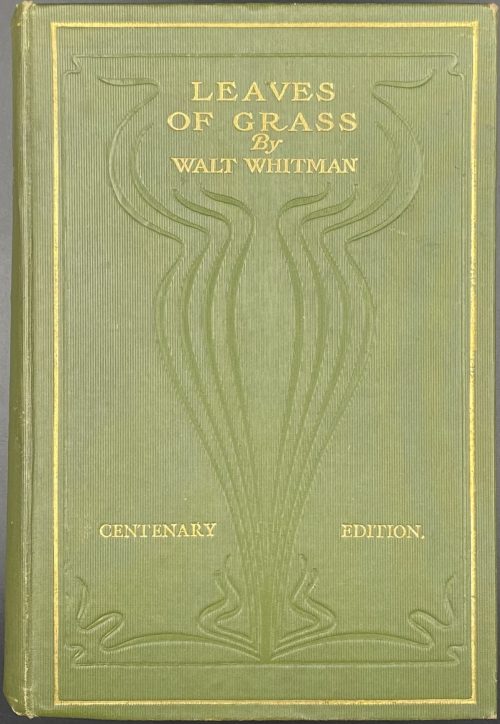 Hardcover, 21.5 x 15 cm, green buckram with gilt border and gilt lettering to front board and spine, blind decorated in art nouveau style, T.E.G. Pagination: [26] 1-294, [4] 1-323 [324], [4] 1-255 [256] [4]; total 912 pages and photo portrait frontispiece. Title-page: THREE VOLUMES IN ONE | LEAVES OF GRASS| WALT WHITMAN | ISSUED UNDER THE | EDITORIAL SUPERVISION OF HIS | LITERARY EXECUTORS, RICHARD MAURICE | BUCKE, THOMAS B. HARNED, AND | HORACE L. TRAUBEL | {device} | D. APPLETON AND COMPANY | New York […] London || For the Russian translation, see LIB-3103.2022 Уолт Уитмен. Листья травы / Пер. с англ. Вступ. статьи К. Чуковского и М. Медельсона. — М.: Государственное издательство художественной литературы, 1955. Contributors: Walter [Walt] Whitman (American, 1819 – 1892) Richard Maurice Bucke (Canadian, 1837 – 1902) Thomas Biggs Harned (American, 1851 – 1921) Horace Logo Traubel (American, 1858 – 1919)
Hardcover, 21.5 x 15 cm, green buckram with gilt border and gilt lettering to front board and spine, blind decorated in art nouveau style, T.E.G. Pagination: [26] 1-294, [4] 1-323 [324], [4] 1-255 [256] [4]; total 912 pages and photo portrait frontispiece. Title-page: THREE VOLUMES IN ONE | LEAVES OF GRASS| WALT WHITMAN | ISSUED UNDER THE | EDITORIAL SUPERVISION OF HIS | LITERARY EXECUTORS, RICHARD MAURICE | BUCKE, THOMAS B. HARNED, AND | HORACE L. TRAUBEL | {device} | D. APPLETON AND COMPANY | New York […] London || For the Russian translation, see LIB-3103.2022 Уолт Уитмен. Листья травы / Пер. с англ. Вступ. статьи К. Чуковского и М. Медельсона. — М.: Государственное издательство художественной литературы, 1955. Contributors: Walter [Walt] Whitman (American, 1819 – 1892) Richard Maurice Bucke (Canadian, 1837 – 1902) Thomas Biggs Harned (American, 1851 – 1921) Horace Logo Traubel (American, 1858 – 1919) -
 Kabuki actor Arashi Kichisaburō III [嵐吉三郎] as Sarushima Sōta [猿島惣太] in the play Hanamo Yoshida Iwao no Matsuwaka [花吉田岩尾松若] staged at Ichimura-za (市村座), theatre in Edo. Artist: Utagawa Kunisada, a.k.a. Toyokuni III (Japanese, 1786 – 1865) [歌川 国貞]. Publisher: Kojimaya Jūbei (Japanese, 1797-1869), seal: Hanmoto, Jū [板元, 十] (Marks 19-043 | 264c. Date seal and double nanushi censor seals Mera & Watanabe – 3rd month of Kaei 6 (1853). Signed: Toyokuni ga [豊国 画] in a red toshidama cartouche. Media: Fan print (uchiwa-e), 223 x 294 mm. Kabuki actor Arashi Kichisaburō III [嵐吉三郎] (Japanese, 1810 – 1864); other names: Arashi Daizaburō III, Arashi Kitsusaburō III Ref.: Art shop Ezoshi Ukiyoe new collection news, vol. 66, 2023.1 (Jan) # 30, p.8.
Kabuki actor Arashi Kichisaburō III [嵐吉三郎] as Sarushima Sōta [猿島惣太] in the play Hanamo Yoshida Iwao no Matsuwaka [花吉田岩尾松若] staged at Ichimura-za (市村座), theatre in Edo. Artist: Utagawa Kunisada, a.k.a. Toyokuni III (Japanese, 1786 – 1865) [歌川 国貞]. Publisher: Kojimaya Jūbei (Japanese, 1797-1869), seal: Hanmoto, Jū [板元, 十] (Marks 19-043 | 264c. Date seal and double nanushi censor seals Mera & Watanabe – 3rd month of Kaei 6 (1853). Signed: Toyokuni ga [豊国 画] in a red toshidama cartouche. Media: Fan print (uchiwa-e), 223 x 294 mm. Kabuki actor Arashi Kichisaburō III [嵐吉三郎] (Japanese, 1810 – 1864); other names: Arashi Daizaburō III, Arashi Kitsusaburō III Ref.: Art shop Ezoshi Ukiyoe new collection news, vol. 66, 2023.1 (Jan) # 30, p.8. -
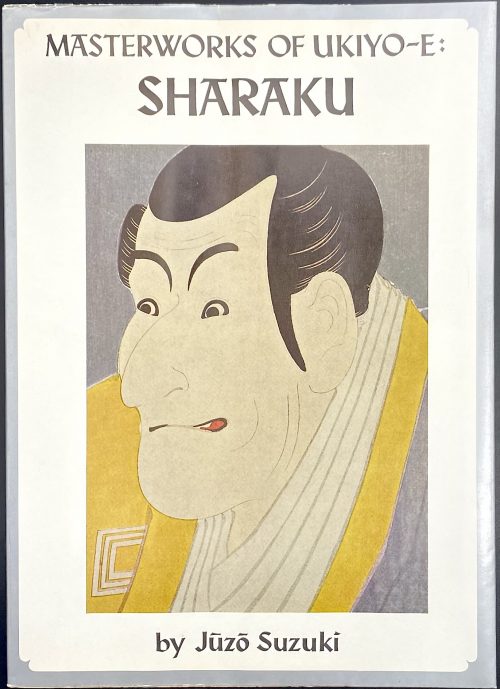 Paperback volume, 25.8 x 18.6 cm, brown embossed wrappers with framed Japanese characters along the outer margin, pictorial dust jacket with series design (black lettering and vignette in silver border to wrappers, black lettering on silver to spine); pp: [1-6]: h.t./frontis. (colour plate pasted in), t.p./imprint, contents/blank), 7-32 text, 33-96 (59 plates w/captions). Title-page (in frame): MASTERWORKS OF UKIYO-E | SHARAKU | by Jūzō Suzuki | Translated by John Bester | {publisher’s device} | KODANSHA INTERNATIONAL LTD. | Tokyo, Japan & Palo-Alto, Calif., U.S.A | {vertical between rules 写楽} || Series: Masterworks of ukiyo-e, № 2. Contributors: Jūzō Suzuki [鈴木 重三] (Japanese, 1919 – 2010) – author. John Bester (British, 1927 – 2010) – translator. Tōshūsai Sharaku [東洲斎 写楽] (Japanese, fl. 1794 – 1795) – artist.
Paperback volume, 25.8 x 18.6 cm, brown embossed wrappers with framed Japanese characters along the outer margin, pictorial dust jacket with series design (black lettering and vignette in silver border to wrappers, black lettering on silver to spine); pp: [1-6]: h.t./frontis. (colour plate pasted in), t.p./imprint, contents/blank), 7-32 text, 33-96 (59 plates w/captions). Title-page (in frame): MASTERWORKS OF UKIYO-E | SHARAKU | by Jūzō Suzuki | Translated by John Bester | {publisher’s device} | KODANSHA INTERNATIONAL LTD. | Tokyo, Japan & Palo-Alto, Calif., U.S.A | {vertical between rules 写楽} || Series: Masterworks of ukiyo-e, № 2. Contributors: Jūzō Suzuki [鈴木 重三] (Japanese, 1919 – 2010) – author. John Bester (British, 1927 – 2010) – translator. Tōshūsai Sharaku [東洲斎 写楽] (Japanese, fl. 1794 – 1795) – artist. -
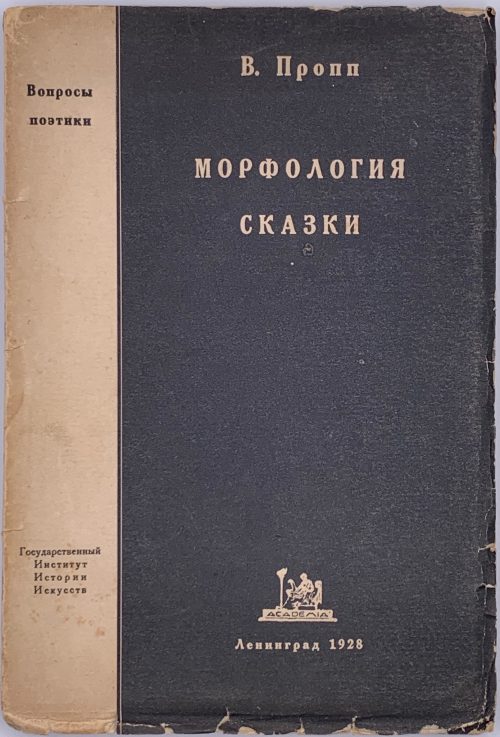 Paperback, 21.3 x 14.5 cm, publisher’s grey and black wrappers with black and grey lettering, respectively; pp. [1-4] 5-151 [1], 152 pages total; collated 8vo: 1-98 104, 76 leaves total. Title-page: В. ПРОПП | МОРФОЛОГИЯ СКАЗКИ | «ACADEMIA» | ЛЕНИНГРАД | 1928 || Frontispiece: ГОСУДАРСТВЕННЫЙ ИНСТИТУТ ИСТОРИИ ИСКУССТВ | ВОПРОСЫ ПОЭТИКИ | НЕПЕРИОДИЧЕСКАЯ СЕРИЯ, ИЗДАВАЕМАЯ | ОТДЕЛОМ СЛОВЕСНЫХ ИСКУССТВ | ВЫПУСК XII | «ACADEMIA» | ЛЕНИНГРАД | 1928 || English title: [LIB-1615.2018] V. Propp. Morphology of the Folktale. — Austin: University of Texas Press, 1979. Print run: 1,600 copies. Catalogue raisonné: Крылов-Кичатова № 328, p. 199. Contributors: Владимир Яковлевич Пропп [Vladimir Propp] (Russian, 1895 – 1970) See also [LIB-1710.2019] (circulation copy) В. Я. Пропп. Исторические корни волшебной сказки (2-е изд.) — Л.: Изд-во ЛГУ, 1986 and (first edition) [LIB-3184.2023] В. Я. Пропп. Исторические корни волшебной сказки. — Л.: Изд-во Ленинградского ун-та, 1946.
Paperback, 21.3 x 14.5 cm, publisher’s grey and black wrappers with black and grey lettering, respectively; pp. [1-4] 5-151 [1], 152 pages total; collated 8vo: 1-98 104, 76 leaves total. Title-page: В. ПРОПП | МОРФОЛОГИЯ СКАЗКИ | «ACADEMIA» | ЛЕНИНГРАД | 1928 || Frontispiece: ГОСУДАРСТВЕННЫЙ ИНСТИТУТ ИСТОРИИ ИСКУССТВ | ВОПРОСЫ ПОЭТИКИ | НЕПЕРИОДИЧЕСКАЯ СЕРИЯ, ИЗДАВАЕМАЯ | ОТДЕЛОМ СЛОВЕСНЫХ ИСКУССТВ | ВЫПУСК XII | «ACADEMIA» | ЛЕНИНГРАД | 1928 || English title: [LIB-1615.2018] V. Propp. Morphology of the Folktale. — Austin: University of Texas Press, 1979. Print run: 1,600 copies. Catalogue raisonné: Крылов-Кичатова № 328, p. 199. Contributors: Владимир Яковлевич Пропп [Vladimir Propp] (Russian, 1895 – 1970) See also [LIB-1710.2019] (circulation copy) В. Я. Пропп. Исторические корни волшебной сказки (2-е изд.) — Л.: Изд-во ЛГУ, 1986 and (first edition) [LIB-3184.2023] В. Я. Пропп. Исторические корни волшебной сказки. — Л.: Изд-во Ленинградского ун-та, 1946. -
![Э. Лиссагарэ. История Парижской Коммуны в 1871 году / С французского. Полный перевод под редакцией В. Базарова. — С.-Петербург. 1906. (Дешевая библиотека товарищества "Знание", № 274). — pp.:[4] [1] 2-524. [Проспер Оливье Лиссагарэ].](https://varshavskycollection.com/wp-content/uploads/2021/02/LIB-1158.2016-d-500x729.jpeg) Hardcover volume, collated in-8o, 21.1 x 14.9 cm, bound in half black polished morocco over green buckram boards, gilt lettering in rules to flat spine, brown diaper over cream endpapers, red ink oval library stamp in Estonian to t.p. «AJALOOMUUSEUM RAAMATUKOGU» (history museum library); pp.: [4] [1] 2-524, total 528 pages; collation π2 1-328 336, total 264 leaves. Title-page: ДЕШЕВАЯ БИБЛIОТЕКА ТОВАРИЩЕСТВА "ЗНАНIЕ". | № 274. | Э. Лиссагарэ. | ИСТОРIЯ ПАРИЖСКОЙ КОММУНЫ | въ 1871 г. | Съ французскаго. Полный переводъ | подъ редакцiей В. Базарова.| С.-ПЕТЕРБУРГЪ | 1906. || Original title: Prosper-Olivier Lissagaray. Histoire de la Commune de 1871. — Paris: E. Dentu, 1876. English translation by Eleanor Marx Aveling: [LIB-1110.2016] Prosper-Olivier Lissagaray. History of the Commune of 1871. — London: Reeves and Turner, 1886. Contributors: Hippolyte Prosper-Olivier Lissagaray (French, 1838 – 1901) – author. Владимир Александрович Базаров [Руднев, Vladimir Bazarov] (Russian, 1874 – 1939) – translator.
Hardcover volume, collated in-8o, 21.1 x 14.9 cm, bound in half black polished morocco over green buckram boards, gilt lettering in rules to flat spine, brown diaper over cream endpapers, red ink oval library stamp in Estonian to t.p. «AJALOOMUUSEUM RAAMATUKOGU» (history museum library); pp.: [4] [1] 2-524, total 528 pages; collation π2 1-328 336, total 264 leaves. Title-page: ДЕШЕВАЯ БИБЛIОТЕКА ТОВАРИЩЕСТВА "ЗНАНIЕ". | № 274. | Э. Лиссагарэ. | ИСТОРIЯ ПАРИЖСКОЙ КОММУНЫ | въ 1871 г. | Съ французскаго. Полный переводъ | подъ редакцiей В. Базарова.| С.-ПЕТЕРБУРГЪ | 1906. || Original title: Prosper-Olivier Lissagaray. Histoire de la Commune de 1871. — Paris: E. Dentu, 1876. English translation by Eleanor Marx Aveling: [LIB-1110.2016] Prosper-Olivier Lissagaray. History of the Commune of 1871. — London: Reeves and Turner, 1886. Contributors: Hippolyte Prosper-Olivier Lissagaray (French, 1838 – 1901) – author. Владимир Александрович Базаров [Руднев, Vladimir Bazarov] (Russian, 1874 – 1939) – translator. -
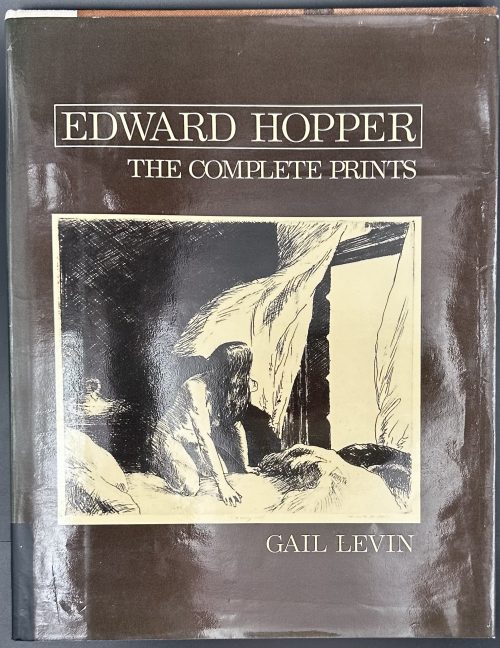 Hardcover volume, 28.6 x 22.4 cm, tan cloth over brown cloth boards, black lettering to spine, blind-stamped lettering in frame to front, in a black pictorial dust jacket, price unclipped; pp.: [1-ix] x-xi [xii blank], [1-4] 5-36 [4], 64 pages with 109 b/w plates, 12 pages with chronology, bibliography, credits; total 128 pp. Title-page: EDWARD HOPPER (in frame)| THE COMPLETE PRINTS | GAIL LEVIN | W • W • NORTON & COMPANY • NEW YORK • LONDON | IN ASSOCIATION WITH THE | WHITNEY MUSEUM OF AMERICAN ART || Contributors: Gail Levin (American, b. 1948) – author. Edward Hopper (American, 1882 – 1967) – artist. W. W. Norton & Company (f. 1923) – publisher. Whitney Museum of American Art (NY) – publisher.
Hardcover volume, 28.6 x 22.4 cm, tan cloth over brown cloth boards, black lettering to spine, blind-stamped lettering in frame to front, in a black pictorial dust jacket, price unclipped; pp.: [1-ix] x-xi [xii blank], [1-4] 5-36 [4], 64 pages with 109 b/w plates, 12 pages with chronology, bibliography, credits; total 128 pp. Title-page: EDWARD HOPPER (in frame)| THE COMPLETE PRINTS | GAIL LEVIN | W • W • NORTON & COMPANY • NEW YORK • LONDON | IN ASSOCIATION WITH THE | WHITNEY MUSEUM OF AMERICAN ART || Contributors: Gail Levin (American, b. 1948) – author. Edward Hopper (American, 1882 – 1967) – artist. W. W. Norton & Company (f. 1923) – publisher. Whitney Museum of American Art (NY) – publisher. -
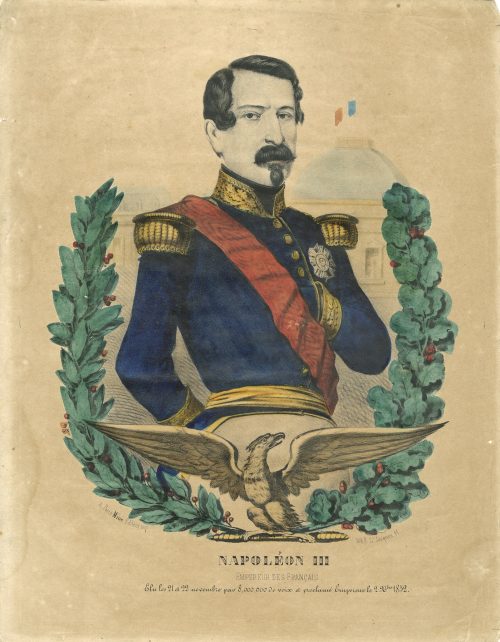 Hand-coloured lithography on wove paper, 380 x 298 mm; black ink stamp “4912” to reverse. On stone left: "A, Paris Miné Éditeur, imp.;" right: "Lith. R. St. Jacques. 41." Bottom center: "Napoléon III"; below: "EMPEREUR DES FRANÇAIS", under: "Élu les 21 el 22 novembre par 8,000,000 de voix et proclamé Empereur le 2 Xbre 1852." Printer/publisher: Miné, éditeur, imprimeur en lithographie, Rue Saint-Jacques, 41. Napoleon III [Charles-Louis Napoléon Bonaparte] (French, 1808 – 1873)
Hand-coloured lithography on wove paper, 380 x 298 mm; black ink stamp “4912” to reverse. On stone left: "A, Paris Miné Éditeur, imp.;" right: "Lith. R. St. Jacques. 41." Bottom center: "Napoléon III"; below: "EMPEREUR DES FRANÇAIS", under: "Élu les 21 el 22 novembre par 8,000,000 de voix et proclamé Empereur le 2 Xbre 1852." Printer/publisher: Miné, éditeur, imprimeur en lithographie, Rue Saint-Jacques, 41. Napoleon III [Charles-Louis Napoléon Bonaparte] (French, 1808 – 1873) -
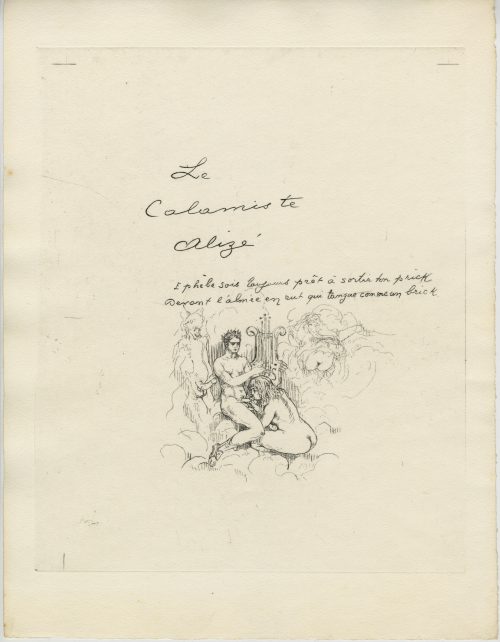 Thirteen unnumbered loose leaves 323 x 249 mm, watermarked BFK Rives, with manuscript text and vignettes produced by etching or, more likely, drypoint (see microphoto), incl. title-page, one full-page illustration and two leaves of text only; versos blank. Some leaves have registration marks. The set is housed in a cream French flapped folder (chemise) without lettering; the seller’s description is pasted to the front cover verso, glassine dust cover. Seller’s description: Cette édition in-folio du recueil de poèmes de Louis de Gonzague Frick, inconnue de Jean-Pierre Dutel, qui « a été tirée à 50 exemplaires (...) est certainement la plus rare (et a été) publiée après 1940 sur vélin (BFK) Rives » (cf. Ader, 3 mars 2020, n°155). Exemplaire « de passe », sans justificatif, complet des 13 planches avec 11 eaux-fortes, dont une à pleine page, d'Auguste Brouet. Ref.: According to honesterotica, the first edition was published in 1938 in 65 copies: "The pink Ingres paper and the loose-leaf format tied with a red ribbon". Another source states: "Le tirage a été effectué avec marges, sur papier vélin BFK Rives au format in-4 (32,5 × 25), les planches mesurant 26,5 × 22 cm. Certains exemplaires sont sur papier blanc - Je remercie le libraire qui a pris la peine de me communiquer ces dernières informations. Pour moi, c'est bien l'édition à 65 qui est l'originale, les deux autres étant des retirages légèrement postérieurs, mais dans le détail desquels le principe de l’œuvre - un manuscrit destiné à quelques amis de l'auteur - a été quelque peu trahi." Contributors: Louis de Gonzague Frick (French, 1883 – 1958) Auguste Brouet (French, 1872 – 1941)
Thirteen unnumbered loose leaves 323 x 249 mm, watermarked BFK Rives, with manuscript text and vignettes produced by etching or, more likely, drypoint (see microphoto), incl. title-page, one full-page illustration and two leaves of text only; versos blank. Some leaves have registration marks. The set is housed in a cream French flapped folder (chemise) without lettering; the seller’s description is pasted to the front cover verso, glassine dust cover. Seller’s description: Cette édition in-folio du recueil de poèmes de Louis de Gonzague Frick, inconnue de Jean-Pierre Dutel, qui « a été tirée à 50 exemplaires (...) est certainement la plus rare (et a été) publiée après 1940 sur vélin (BFK) Rives » (cf. Ader, 3 mars 2020, n°155). Exemplaire « de passe », sans justificatif, complet des 13 planches avec 11 eaux-fortes, dont une à pleine page, d'Auguste Brouet. Ref.: According to honesterotica, the first edition was published in 1938 in 65 copies: "The pink Ingres paper and the loose-leaf format tied with a red ribbon". Another source states: "Le tirage a été effectué avec marges, sur papier vélin BFK Rives au format in-4 (32,5 × 25), les planches mesurant 26,5 × 22 cm. Certains exemplaires sont sur papier blanc - Je remercie le libraire qui a pris la peine de me communiquer ces dernières informations. Pour moi, c'est bien l'édition à 65 qui est l'originale, les deux autres étant des retirages légèrement postérieurs, mais dans le détail desquels le principe de l’œuvre - un manuscrit destiné à quelques amis de l'auteur - a été quelque peu trahi." Contributors: Louis de Gonzague Frick (French, 1883 – 1958) Auguste Brouet (French, 1872 – 1941) -
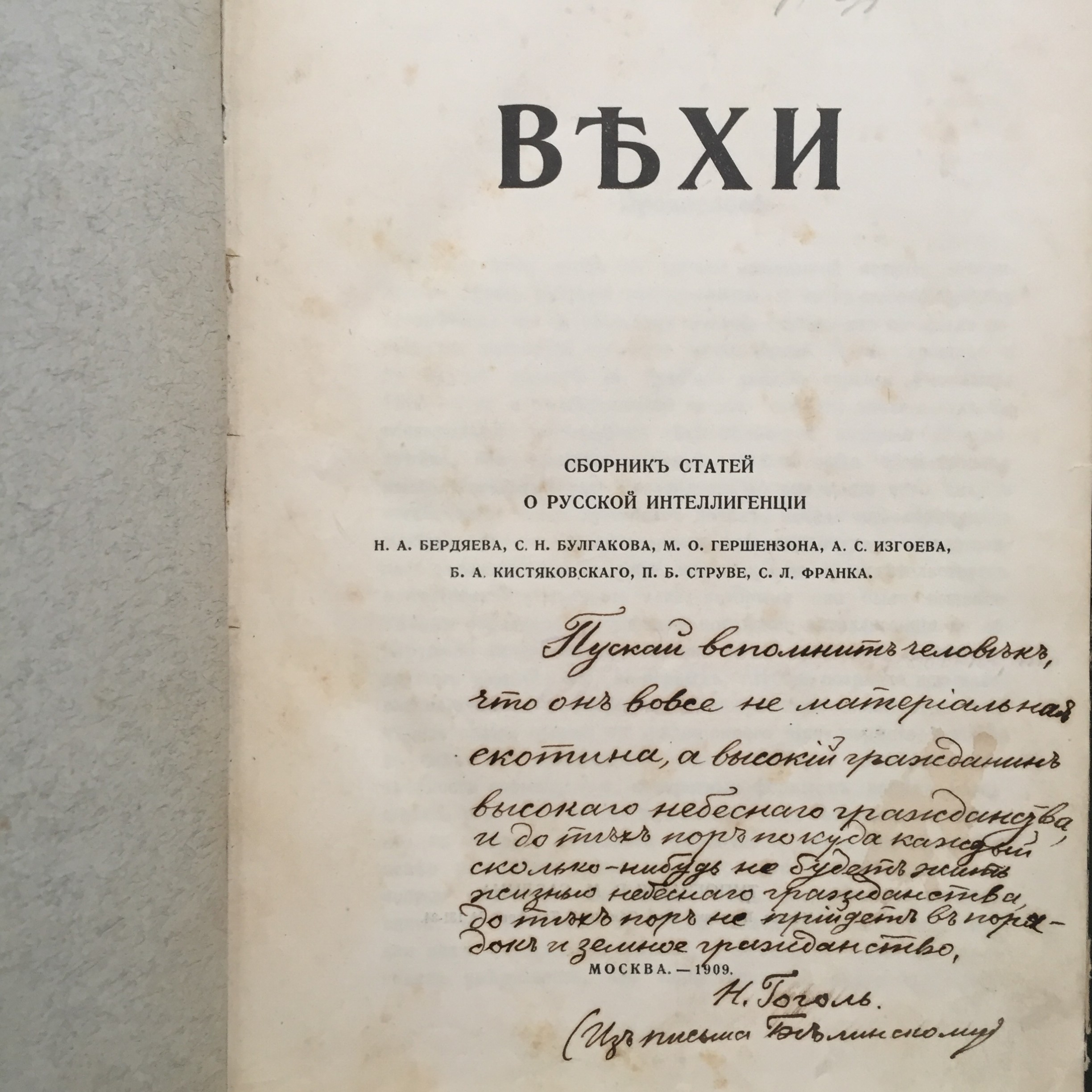
Вехи. Сборник статей о русской интеллигенции. Москва, 1909. Типография В. М. Саблина.
Предисловие. М. О. Гершензон. Н. А. Бердяев. Философская истина и интеллигентская правда. С. Н. Булгаков. Героизм и подвижничество. М. О. Гершензон. Творческое самосознание. Б. А. Кистяковский. В защиту права. П. Б. Струве. Интеллигенция и революция. С. Л. Франк. Этика нигилизма. А. С. Изгоев. Об интеллигентной молодежи. -

Fuchi-kashira made of shakudō carved and inlaid with gold and red copper with the design of a bat and a fruit (persimmon?). Nanako surface.
Fuchi: 37 x 19 x 7 mm. Kashira: 34 x 16 x 5 mm. Main material: shakudō. Other metals: gold and copper. Surface treatment: nanako-ji. -
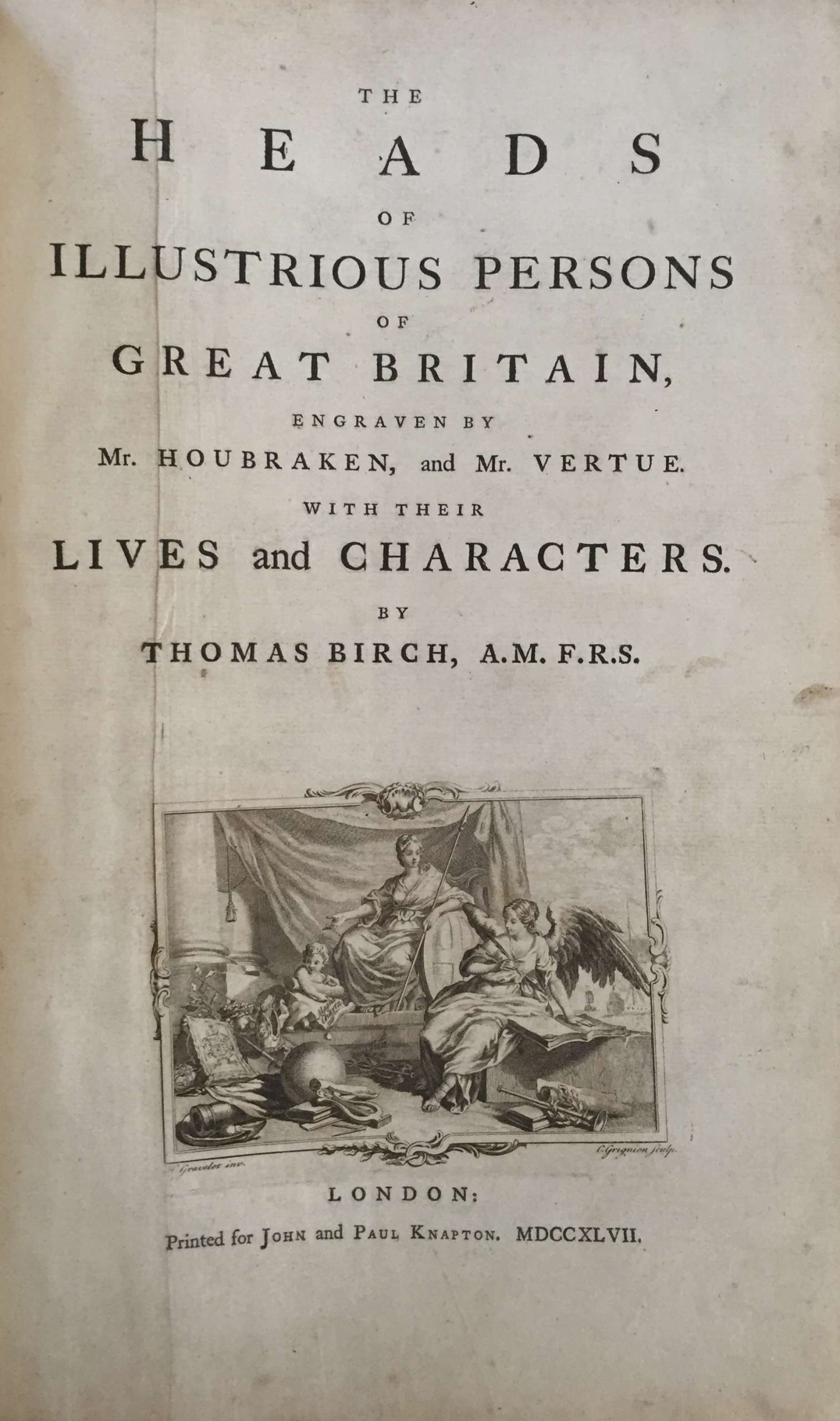
The Heads of Illustrious Persons of Great Britain Engraven By Mr. Houbraken And Mr. Vertue. With Their Lives And Characters by Thomas Birch, A.M.F.R.S. Two Volumes in One. Published for John and Paul Knapton, London, 1747. 108 engraved portraits.
-
 Iron tsuba of round form with design of triple diamond (matsukawa-bishi) in openwork (sukashi). Square rim. Ko-Tosho school. Nanbokucho period: Late 14th century (Oan/Eiwa era). Height: 92.3 mm. Width: 92.3 mm. Rim thickness: 2.5 mm. Center thickness: 3.0 mm. Provenance: Sasano Masayuki Collection, № 15: "Two small lozenges are attached to each end of a larger lozenge. Most Ko-tosho tsuba have inspirational designs, however this has a rather casual appearance, although it represents the unstable political situation at the time".
Iron tsuba of round form with design of triple diamond (matsukawa-bishi) in openwork (sukashi). Square rim. Ko-Tosho school. Nanbokucho period: Late 14th century (Oan/Eiwa era). Height: 92.3 mm. Width: 92.3 mm. Rim thickness: 2.5 mm. Center thickness: 3.0 mm. Provenance: Sasano Masayuki Collection, № 15: "Two small lozenges are attached to each end of a larger lozenge. Most Ko-tosho tsuba have inspirational designs, however this has a rather casual appearance, although it represents the unstable political situation at the time". -
 Iron tsuba of round form with design of rabbit (usagi) in openwork (sukashi) and inlaid with designs of plants and family crests (mon) in suemon-zōgan. A branch with lonely leaf, half chrysanthemum, and flying wild geese on the face represent autumnal connotations. The same motif is complemented by a clove (choji) on the reverse. The family crests (mon) include: interlocked rings (kanawa; wachigai), three encircled lines or stripes (hikiryo), bit or muzzle (kutsuwa - horse's harness element with possible christian symbolism), and encircled triangle (uroko, fish scale). Brass wire trim around the openwork elements and the seppa-dai, scalloped wire inlay around the hitsu-ana. Iron is dark, almost black. Brass or copper elements vary in shades of lighter and darker yellow with red-ish hue. Ōnin school. Late Muromachi period, 16th century. Height: 89.6 mm; Width: 89.3 mm; Thickness at seppa-dai: 3.0 mm. Weight: 129.7 g.
Iron tsuba of round form with design of rabbit (usagi) in openwork (sukashi) and inlaid with designs of plants and family crests (mon) in suemon-zōgan. A branch with lonely leaf, half chrysanthemum, and flying wild geese on the face represent autumnal connotations. The same motif is complemented by a clove (choji) on the reverse. The family crests (mon) include: interlocked rings (kanawa; wachigai), three encircled lines or stripes (hikiryo), bit or muzzle (kutsuwa - horse's harness element with possible christian symbolism), and encircled triangle (uroko, fish scale). Brass wire trim around the openwork elements and the seppa-dai, scalloped wire inlay around the hitsu-ana. Iron is dark, almost black. Brass or copper elements vary in shades of lighter and darker yellow with red-ish hue. Ōnin school. Late Muromachi period, 16th century. Height: 89.6 mm; Width: 89.3 mm; Thickness at seppa-dai: 3.0 mm. Weight: 129.7 g. -
 Richard Parkes Bonington (1802–1828 ). British/French. Evreux: Tour du Gros Horloge (Evreux: Large Clock Tower). Inscription: The tower was built in 1417 when the area was ruled by England. Lithograph. From the Taylor and Nodier set "Normandie", Vol. II, pl. 226. 1824. MET# 22.87.2. Catalogue Raisonné: Curtis 1939, no. 19. MET description: "This view in the French town of Evreux focuses on the clock tower, with vendors and customers in the street below. Bonington produced the print for the multi-volume series directed by Baron Isidore Taylor, Charles Nodier and Alphonse de Cailleux titled "Voyages Pittoresques et Romantiques dans l'Ancienne France" (Picturesque and Romantic Travels through Historic France). This image appears in volume 2, devoted to Normandy."
Richard Parkes Bonington (1802–1828 ). British/French. Evreux: Tour du Gros Horloge (Evreux: Large Clock Tower). Inscription: The tower was built in 1417 when the area was ruled by England. Lithograph. From the Taylor and Nodier set "Normandie", Vol. II, pl. 226. 1824. MET# 22.87.2. Catalogue Raisonné: Curtis 1939, no. 19. MET description: "This view in the French town of Evreux focuses on the clock tower, with vendors and customers in the street below. Bonington produced the print for the multi-volume series directed by Baron Isidore Taylor, Charles Nodier and Alphonse de Cailleux titled "Voyages Pittoresques et Romantiques dans l'Ancienne France" (Picturesque and Romantic Travels through Historic France). This image appears in volume 2, devoted to Normandy." -
 Iron tsuba of mokko form with slanting rays of light (shakoh) Christian motif (Jesuit's IHS symbol) in openwork (sukashi). Traditional description of this kind of design is called "tokei", or "clock gear". Owari school. Edo period.
Iron tsuba of mokko form with slanting rays of light (shakoh) Christian motif (Jesuit's IHS symbol) in openwork (sukashi). Traditional description of this kind of design is called "tokei", or "clock gear". Owari school. Edo period.Size: 83.4 x 83.1 x 4.4 mm
NTHK certified KANTEISHO ("Important Work"). In a custom wooden box. For information regarding shakoh tsuba see article 'Kirishitan Ikenie Tsuba by Fred Geyer at Kokusai Tosogu Kai; The 2nd International Convention & Exhibition, October 18-23, 2006, pp. 84-91. -
 Iron tsuba of round form decorated with dragonfly (tombo) and comma (comma-like swirl, tomoe) in openwork (sukashi) outlined with brass wire. The plate decorated with 5 concentric circular rows of brass dots in ten-zōgan. Center of the plate outlined with the inlaid circular brass wire (sen-zōgan). Ōnin school. Unsigned. Mid Muromachi period, middle of the 15th century. Dimensions: Diameter: 89.5 mm, thickness: 3.1 mm. Notes regarding design: "According to various sources, the dragonfly (tombo) is emblematic of martial success, as various names for the insect are homophones for words meaning "victory". The dragonfly is also auspicious because references in the Kojiki and Nihongi link it in both name and shape to the old kingdom of Yamato." [Merrily Baird. Symbols of Japan. Thematic motifs in art and design. Rizzoli international publications, Inc., 2001, p. 108]. "The dragonfly (tonbo), was also called kachimushi in earlier times, and due to the auspicious literal meaning "victory bug" of the characters of this word it became a popular theme on sword fittings." [Iron tsuba. The works of the exhibition "Kurogane no hana", The Japanese Sword Museum, 2014, p. 13]. Helen C. Gunsaulus' description of the dragonfly emblem is as follows: "This motive, the dragon-fly (akitsu), is generally accepted as a symbol of the kingdom of Japan, and the origin of the idea is traced to the legend recounted in the Kojiki and Nihongo of the Emperor Jimmu's view of the island from mountain top. He is said to have thought the kingdom looked like a dragon-fly touching its tail with its mouth. From this it received its name Akitsu-shima... etc."
Iron tsuba of round form decorated with dragonfly (tombo) and comma (comma-like swirl, tomoe) in openwork (sukashi) outlined with brass wire. The plate decorated with 5 concentric circular rows of brass dots in ten-zōgan. Center of the plate outlined with the inlaid circular brass wire (sen-zōgan). Ōnin school. Unsigned. Mid Muromachi period, middle of the 15th century. Dimensions: Diameter: 89.5 mm, thickness: 3.1 mm. Notes regarding design: "According to various sources, the dragonfly (tombo) is emblematic of martial success, as various names for the insect are homophones for words meaning "victory". The dragonfly is also auspicious because references in the Kojiki and Nihongi link it in both name and shape to the old kingdom of Yamato." [Merrily Baird. Symbols of Japan. Thematic motifs in art and design. Rizzoli international publications, Inc., 2001, p. 108]. "The dragonfly (tonbo), was also called kachimushi in earlier times, and due to the auspicious literal meaning "victory bug" of the characters of this word it became a popular theme on sword fittings." [Iron tsuba. The works of the exhibition "Kurogane no hana", The Japanese Sword Museum, 2014, p. 13]. Helen C. Gunsaulus' description of the dragonfly emblem is as follows: "This motive, the dragon-fly (akitsu), is generally accepted as a symbol of the kingdom of Japan, and the origin of the idea is traced to the legend recounted in the Kojiki and Nihongo of the Emperor Jimmu's view of the island from mountain top. He is said to have thought the kingdom looked like a dragon-fly touching its tail with its mouth. From this it received its name Akitsu-shima... etc."


